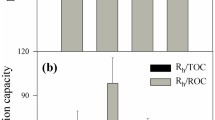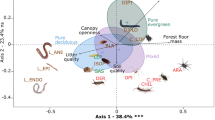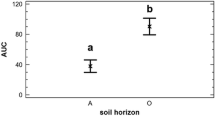Abstract
We analyzed the influence of above- and belowground factors on the soil microbial community in a Chinese subtropical forest, one of the most diverse biomes in the northern hemisphere. Soil samples were taken at different depths from four replicate comparative study plots in each of three forest age classes (young 10–40 years, medium 40–80 years, old ≥80 years). Microbial biomass and community structure were then determined using phospholipid fatty acid (PLFA) analysis, and basal respiration and microbial biomass carbon (Cmic) were determined by substrate-induced respiration. These data were then related to plant community and soil variables using non-metric multidimensional scaling analysis and post-hoc permutational correlations. We found that microbial lipid composition and abundance were not related to forest age class. Instead, microbial lipid composition and abundance were related to factors reflecting primary production, i.e., percent litter cover, percent dead wood cover, and percent tree layer cover. Specifically, the relative abundance (mol fraction) of indicators for arbuscular mycorrhizal fungi, Gram-positive and Gram-negative bacteria were positively significantly correlated with percent litter cover. We also found that the biomass of all microbial groups and total PLFA were negatively significantly related to percent deadwood cover. In addition, \( {\text{pH}}_{{{\text{H}}_{ 2} {\text{O}}}} \) was the only soil parameter that was correlated significantly to microbial biomass. Our results indicate that overarching ecological factors such as plant productivity and soil pH are important factors influencing the soil microbial community, both in terms of biomass and of community composition in this subtropical ecosystem.


Similar content being viewed by others
References
Boden Ad-hoc-AG. 2005. Bodenkundliche kartieranleitung. 5th edn. Hannover: Bundesanstalt für Geowissenschaft-en und Rohstoffe. p 438.
Alexander I, Lee SS. 2005. Mycorrhizas and ecosystem processes in tropical rain forest: implications for diversity. In: Burslem DFRP, Pinard MA, Hartley SE, Eds. Biotic interactions in the tropics: their role in the maintenance of species diversity. Cambridge: Cambridge University Press. p 165–203.
Anderson JPE, Domsch KH. 1973. Quantification of bacterial and fungal contributions to soil respiration. Arch Microbiol 93:113–27.
Anderson JPE, Domsch KH. 1978. A physiological method for the quantitative measurement of microbial biomass in soils. Soil Biol Biochem 10:215–21.
Anderson TH. 1985. Determination of ecophysiological maintenance carbon requirements of soil microorganisms in a dormant state. Biol Fertil Soils 1:81–9.
Anderson TH, Domsch KH. 1990. Application of eco-physiological quotients (qCO2 and qD) on microbial biomasses from soils of different cropping histories. Soil Biol Biochem 22:251–5.
Anderson TH. 2003. Microbial eco-physiological indicators to assess soil quality. Agric Ecosyst Environ 98:285–93.
Bååth E, Anderson TH. 2003. Comparison of soil fungal/bacterial ratios in a pH gradient using physiological and PLFA-based techniques. Soil Biol Biochem 35:955–63.
Bååth E. 2003. The use of neutral lipid fatty acids to indicate the physiological conditions of soil fungi. Microb Ecol 45:373–83.
Balser TC, Treseder KK, Eklener M. 2005. Using lipid analysis and hyphal length to quantify AM and saprotrophic fungal abundance along a soil chronosequence. Soil Biol Biochem 37:601–4.
Balvanera P, Pfisterer AB, Buchmann N, He JS, Nakashizuka T, Raffaelli D, Schmid B. 2006. Quantifying the evidence for biodiversity effects on ecosystem functioning and services. Ecol Lett 9:1146–56.
Bardgett RD, Freeman C, Ostle NJ. 2008. Microbial contributions to climate change through carbon cycle feedbacks. ISME J 2:805–14.
Bartelt-Ryser J, Joshi J, Schmid B, Brandl H, Balser T. 2005. Soil feedbacks of plant diversity on soil microbial communities and subsequent plant growth. Perspect Plant Ecol Evol Syst 7:27–49.
Bausenwein U, Gattinger A, Langer U, Embacher A, Hartmann HP, Sommer M, Munch JC, Schloter M. 2008. Exploring soil microbial communities and soil organic matter: variability and interactions in arable soils under minimum tillage practice. Appl Soil Ecol 40:67–77.
Bezemer TM, Fountain MT, Barea JM, Christensen S, Dekker SC, Duyts H, van Hal R, Harvey JA, Hedlund K, Maraun M, Mikola J, Mladenov AG, Robin C, de Ruiter PC, Scheu S, Setälä H, Šmilauer P, van der Putten WH. 2010. Divergent composition but similar function of soil food webs beneath individual plants: plant species and community effects. Ecology 91:3027–36.
Binkley D, Giardina C. 1998. Why do tree species affect soils? The warp and woof of tree-soil interactions. Biogeochemistry 42:89–106.
Bligh E, Dyer W. 1959. A rapid method of total lipid extraction and purification. Can J Biochem Physiol 37:911–17.
Both S, Fang T, Böhnke M, Bruelheide H, Geißler C, Kühn P, Scholten T, Trogisch S, Erfmeier A. 2011. Lack of tree layer control on herb layer characteristics in a subtropical forest, China. J Veg Sci. doi:10.1111/j.1654-1103.2011.01324.x.
Bossio DA, Scow KM, Gunapala N, Graham KJ. 1998. Determinants of soil microbial communities: effects of agricultural management, Season, and soil type on phospholipid fatty acid profiles. Microb Ecol 36:1–12.
Boyle SA, Yarwood RR, Bottomley PJ, Myrold DD. 2008. Bacterial and fungal contributions to soil nitrogen cycling under Douglas fir and red alder at two sites in Oregon. Soil Biol Biochem 40:443–51.
Bruelheide H, Böhnke M, Both S, Fang T, Assmann T, Baruffol M, Bauhus J, Buscot F, Chen XY, Ding BY, Durka W, Erfmeier A, Fischer M, Geißler C, Guo DL, Härdtle W, He JS, Hector A, Kröber W, Kühn P, Lang AC, Nadrowski K, Pei KQ, Scherer-Lorenzen M, Shi XZ, Scholten T, Schuldt A, Trogisch S, von Oheimb G, Welk E, Wirth C, Wu YT, Yang XF, Zeng XQ, Zhang SR, Zhou HZ, Ma KP, Schmid B. 2011. Community assembly during secondary forest succession in a Chinese subtropical forest. Ecol Monogr 81:25–41.
Cannell MGR. 1984. Woody biomass of forest stands. For Ecol Manage 8:299–312.
Carney KM, Matson PA. 2005. Plant communities, soil microorganisms, and soil carbon cycling: does altering the world belowground matter to ecosystem functioning? Ecosystems 8:928–40.
Carney KM, Matson PA. 2006. The influence of tropical plant diversity and composition on soil microbial communities. Microb Ecol 52:226–38.
Clausen CA. 1996. Bacterial associations with decaying wood: a review. Int Biodeterior Biodegradation 37:101–7.
Cornwell WK, Cornelissen JHC, Allison SD, Bauhus J, Eggleton P, Preston CM, Scarff F, Weedon JT, Wirth C, Zanne AE. 2009. Plant traits and wood fates across the globe: rotted, burned, or consumed? Glob Change Biol 15:2431–49.
FAO. 2006. Guidelines for soil description. 4th edn. Rome: FAO.
Fierer N, Schime JP, Holden PA. 2003. Variations in microbial community composition through two soil depth profiles. Soil Biol Biochem 35:167–76.
Fraterrigo JM, Balser TC, Turner MG. 2006. Microbial community variation and its relationship with nitrogen mineralization in historically altered forests. Ecology 87:570–9.
Fritze H, Smolander A, Levula T, Kitunen V, Mälkönen E. 1994. Wood-ash fertilization and fire treatment in a Scots pine forest stand: effects on the organic layer, microbial biomass, and microbial activity. Biol Fertil Soils 17:57–63.
Frostegård Å, Tunlid A, Bååth E. 1991. Microbial biomass measured as total lipid phosphate in soils of different organic content. J Microbiol Methods 14:151–63.
Frostegård Å, Bååth E, Tunlid A. 1993. Shifts in the structure of soil microbial communities in limed forests as revealed by phospholipid fatty acid analysis. Soil Biol Biochem 25:723–30.
Frostegård A, Bååth E. 1996. The use of fatty acid analysis to estimate bacterial and fungal biomass in soil. Biol Fertil Soils 22:59–65.
Geißler C, Kühn P, Böhnke M, Bruelheide H, Shi X, Scholten T. 2011. Splash erosion potential under tree canopies in subtropical SE China. Catena 174:596–601.
Gershenson A, Bader NE, Cheng WX. 2009. Effects of substrate availability on the temperature sensitivity of soil organic matter decomposition. Glob Change Biol 15:176–83.
Groffman PM, Eagan P, Sullivan WM, Lemunyon JL. 1996. Grass species and soil type effects on microbial biomass and activity. Plant Soil 183:61–7.
Gutknecht JLM, Field CB, Balser TC. 2012. Microbial response to simulated global change: temporal patterns as an important context. Glob Change Biol (In press).
Heinemeyer O, Insam H, Kaiser EA, Walenzik G. 1989. Soil microbial biomass and respiration measurements: an automated technique based on infra-red analysis. Plant Soil 116:191–5.
Hernesmaa A, Björklöf K, Kiikkila O, Fritze H, Haahtela K, Romantschuk M. 2005. Structure and function of microbial communities in the rhizosphere of Scots pine after tree-felling. Soil Biol Biochem 37:777–85.
Hill TCJ, McPherson EF, Harris JA, Birch P. 1993. Microbial biomass estimated by phospholipid phosphate in soils with diverse microbial communities. Soil Biol Biochem 25:1779–86.
Hodge A, Campbell CD, Fitter AH. 2001. An arbuscular mycorrhizal fungus accelerates decomposition and acquires nitrogen directly from organic material. Nature 413:297–9.
Högberg MN, Högberg P, Myrold DD. 2007. Is microbial community composition in boreal forest soils determined by pH, C-to-N ratio, the trees, or all three? Oecologia 150:590–601.
Hooper DU, Vitousek PM. 1997. The effects of plant composition and diversity on ecosystem processes. Science 277:1302–5.
Hooper DU, Bignell DE, Brown VK, Brussaard L, Dangerfield JM, Wall DH, Wardle DA, Coleman DC, Giller KE, Lavelle P, Van der Putten WH, De Ruiter PC, Rusek J, Silver WL, Tiedje JM, Wolters V. 2000. Interactions between aboveground and belowground biodiversity in terrestrial ecosystems: patterns, mechanisms, and feedbacks. Bioscience 50:1049–61.
Hooper DU, Chapin FS, Ewel JJ, Hector A, Inchausti P, Lavorel S, Lawton JH, Lodge DM, Loreau M, Naeem S, Schmid B, Setala H, Symstad AJ, Vandermeer J, Wardle DA. 2005. Effects of biodiversity on ecosystem functioning: a consensus of current knowledge. Ecol Monogr 75:3–35.
Hu ZH, Yu MJ. 2008. Study on successions sequence of evergreen broad-leaved forest in Gutian Mountain of Zhejiang, Eastern China: species diversity. Front Biol China 3:45–9.
Ingham RE, Trofymow JA, Ingham ER, Coleman DC. 1985. Interactions of bacteria, fungi, and their nematode grazers: effects on nutrient cycling and plant growth. Ecol Monogr 55:119–40.
IUSS Working Group WRB. 2007. World reference base for soil resources 2006. First update 2007. World Soil Resources Reports No. 103. FAO, Rome.
Johnson D, Booth RE, Whiteley AS, Bailey MJ, Read DJ, Grime JP, Leake JR. 2003. Plant community composition affects the biomass, activity, and diversity of microorganisms in limestone grassland soil. Eur J Soil Sci 54:671–7.
Kao-Kniffin J, Balser TC. 2008. Soil fertility and the impact of exotic invasion on microbial communities in Hawaiian forests. Microb Ecol 56:55–63.
Kier G, Mutke J, Dinerstein E, Ricketts TH, Küper W, Kreft H, Barthlott W. 2005. Global patterns of plant diversity and floristic knowledge. J Biogeogr 32:1107–16.
Langer U, Klimanek EM. 2006. Soil microbial diversity of four German long-term field experiments. Arch Agron Soil Sci 52:507–23.
Langer U, Rinklebe J. 2009. Lipid biomarkers for assessment of microbial communities in floodplain soils of the Elbe River (Germany). Wetlands 29:353–62.
Legendre P, Mi XC, Ren HB, Ma KP, Yu MJ, Sun IF, He FL. 2009. Partitioning beta diversity in a subtropical broad-leaved forest of China. Ecology 90:663–74.
Mao DM, Min YW, Yu LL, Martens R, Insam H. 1992. Effect of afforestation on microbial biomass and activity in soils of tropical China. Soil Biol Biochem 24:865–72.
McSpadden Gardener B, Lilley A. 1997. Application of common statistical tools. In: Elsas J, van Trevors J, Wellington E, Eds. Modern soil microbiology. New York: Marcel Dekker Inc. p 501–24.
McTiernan KB, Ineson P, Coward PA. 1997. Respiration and nutrient release from tree leaf litter mixtures. Oikos 78:527–38.
Melero S, Porras JCR, Herencia JF, Madejon E. 2006. Chemical and biochemical properties in a silty loam soil under conventional and organic management. Soil Tillage Res 90:162–70.
Moore-Kucera J, Dick RP. 2008. PLFA profiling of microbial community structure and seasonal shifts in soils of a Douglas-fir chronosequence. Microb Ecol 55:500–11.
McCune B, Grace JB. 2002. Analysis of ecological communities. Gleneden Beach (OR): MjM Software Design.
Nottingham AT, Griffiths H, Chamberlain PM, Stott AW, Tanner EVJ. 2009. Soil priming by sugar and leaf-litter substrates: a link to microbial groups. Appl Soil Ecol 42:183–90.
Oksanen J, Kinddt R, Legendre P, O′Hara B. 2006. Vegan: community ecology package. http://cc.oulu.fi/~jarioksa/.
Olsson PA. 1999. Signature fatty acids provide tools for determination of the distribution and interactions of mycorrhizal fungi in soil. FEMS Microbiol Ecol 29:303–10.
Pennanen T, Liski J, Bååth E, Kitunen V, Uotila J, Westman CJ, Fritze H. 1999. Structure of the microbial communities in coniferous forest soils in relation to site fertility and stand development stage. Microb Ecol 38:168–79.
Polit JI, Brown S. 1996. Mass and nutrient content of dead wood in a central Illinois floodplain forest. Wetlands 16:488–94.
Porazinska DL, Bardgett RD, Blaauw MB, Hunt HW, Parsons AN, Seastedt TR, Wall DH. 2003. Relationships at the aboveground-belowground interface: plants, soil biota and soil processes. Ecology 73:377–95.
Prosser JI, Bohannan BJM, Curtis TP, Ellis RJ, Firestone MK, Freckleton RP, Green JL, Green LE, Killham K, Lennon JJ, Osborn AM, Solan M, van der Gast CJ, Young JPW. 2007. The role of ecological theory in microbial ecology. Nat Rev Microbiol 5:384–92.
Ramette A. 2007. Multivariate analysis in microbial ecology. FEMS Microbiol Ecol 62:142–60.
R Development Core Team. 2008. R: A language and environment for statistical computing. Vienna: R Foundation for Statistical Computing.
Rinklebe J, Langer U. 2006. Microbial diversity in three floodplain soils at the Elbe River (Germany). Soil Biol Biochem 38:2144–51.
Saetre P. 1999. Spatial patterns of ground vegetation, soil microbial biomass and activity in a mixed spruce-birch stand. Ecography 22:183–92.
Scherer-Lorenzen M, Bonilla JL, Potvin C. 2007. Tree species richness affects litter production and decomposition rates in a tropical biodiversity experiment. Oikos 116:2108–24.
Schimel JP, Bennett J. 2004. Nitrogen mineralization: challenges of a changing paradigm. Ecology 85:591–602.
Smithwick EAH, Turner MG, Metzger KL, Balser TC. 2005. Variation in NH4 + mineralization and microbial communities with stand age in lodgepole pine (Pinus contorta) forests, Yellowstone National Park (USA). Soil Biol Biochem 37:1546–59.
Steenwerth KL, Jackson LE, Calderón FJ, Stromberg MR, Scow KM. 2003. Soil microbial lipid composition and land use history in cultivated and grassland ecosystems of coastal California. Soil Biol Biochem 35:489–500.
Ushio M, Wagai R, Balser TC, Kitayama K. 2008. Variations in the soil microbial community composition of a tropical montane forest ecosystem: does tree species matter? Soil Biol Biochem 40:2699–702.
Vestal JR, White DC. 1989. Lipid analysis in microbial ecology quantitative approaches to the study of microbial communities. Bioscience 39:535–41.
Waldrop MP, Balser TC, Firestone MK. 2000. Linking microbial lipid composition to function in a tropical soil. Soil Biol Biochem 32:1837–46.
Wardle DA, Bardgett RD, Klironomos JN, Setälä H, van der Putten WH, Wall DH. 2004. Ecological linkages between aboveground and belowground biota. Science 304:1629–33.
Whelan MJ, Anderson JM. 1996. Modeling spatial patterns of throughfall and interception loss in a Norway spruce (Picea abies) plantation at the plot scale. J Hydrol 186:335–54.
White DC, Davis WM, Nickels JS, King JD, Bobbie RJ. 1979. Determination of the sedimentary microbial biomass by extractible lipid phosphate. Oecologia 40:51–62.
Wilkinson SC, Anderson JM. 2001. Spatial patterns of soil microbial communities in a Norway spruce (Picea abies) plantation. Microb Ecol 42:248–55.
Wilkinson SC, Anderson JM, Scardelis SP, Tisiafouli M, Taylor A, Wolters V. 2002. PLFA profiles of microbial communities in decomposing conifer litters subject to moisture stress. Soil Biol Biochem 34:189–200.
Wu YP, Ding N, Wang G, Xu JM, Wu JJ, Brookes PC. 2009. Effects of different soil weights, storage times and extraction methods on soil phospholipid fatty acid analyses. Geoderma 150:171–8.
Yang JC, Insam H. 1991. Microbial biomass and relative contributions of bacteria and fungi in soil beneath tropical rain forest, Hainan Island, China. J Trop Ecol 7:385–93.
Yeates GW. 1999. Effects of plants on nematode community structure. Annu Rev Phytopathol 37:127–49.
Zak DR, Tilman D, Parmenter RR, Rice CW, Fisher FM, Vose J, Milchunas D, Martin CW. 1994. Plant production and soil microorganisms in late-successional ecosystems: a continental-scale study. Ecology 75:2333–47.
Zak DR, Holmes WE, White DC, Peacock AD, Tilman D. 2003. Plant diversity, microbial communities, and ecosystem function: are there any links? Ecology 84:2042–50.
Zelles L, Bai QY, Beck T, Beese F. 1992. Signature fatty acids in phospholipids and lipopolysaccharides as indicators of microbial biomass and community structure in agricultural soils. Soil Biol Biochem 24:317–23.
Zhang QH, Zak JC. 1995. Effects of gap size on litter decomposition and microbial activity in a subtropical forest. Ecology 76:2196–204.
Acknowledgments
We are grateful to the staff of the Gutianshan NNR and the students Bo Tong and Bo Yang for their field assistance. We also thank Annette Gurenowitz for the help with lipid analysis and Wenzel Kröber for providing leaf trait data. Funding for the project was mainly received from the German Research Foundation (DFG) (Grant BU 941/12-1 in the Research Unit FOR 891/1) and additionally from the Helmholtz Impulse and Networking Fund through the Helmholtz Interdisciplinary Graduate School for Environmental Research (HIGRADE).
Author information
Authors and Affiliations
Corresponding author
Additional information
Author Contributions
Yu Ting Wu: sampling in the field and preparation, analyses and data evaluation, writing of the manuscript; Jessica Gutknecht: data evaluation and interpretation, manuscript revision; Karin Nadrowski: data evaluation and interpretation; Christian Geißler; Peter Kühn; and Thomas Scholten: sampling in the field and preparation, elicitation and provision of soil parameters; Sabine Both; Alexandra Erfmeier; and Martin Böhnke: delivery of vegetation structure; Helge Bruelheide: delivery of vegetation structure, manuscript revision; Tesfaye Wubet: manuscript revision; François Buscot: coordination and idea of the project, manuscript revision.
Electronic supplementary material
Below is the link to the electronic supplementary material.
Rights and permissions
About this article
Cite this article
Wu, Y.T., Gutknecht, J., Nadrowski, K. et al. Relationships Between Soil Microorganisms, Plant Communities, and Soil Characteristics in Chinese Subtropical Forests. Ecosystems 15, 624–636 (2012). https://doi.org/10.1007/s10021-012-9533-3
Received:
Accepted:
Published:
Issue Date:
DOI: https://doi.org/10.1007/s10021-012-9533-3




